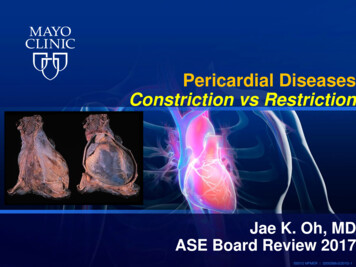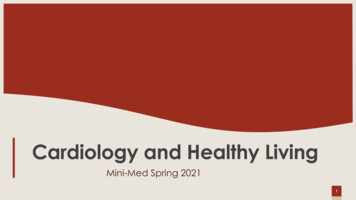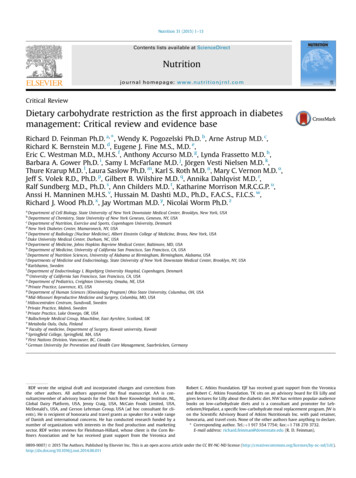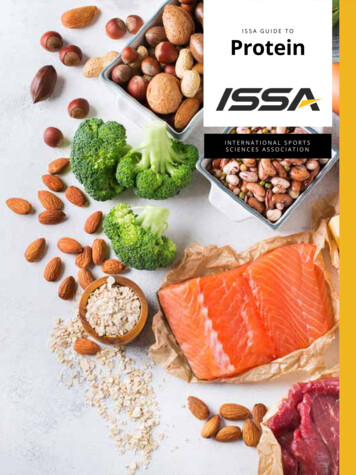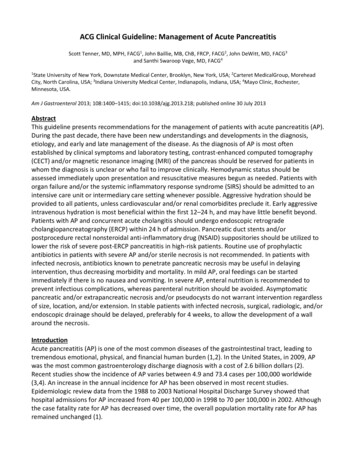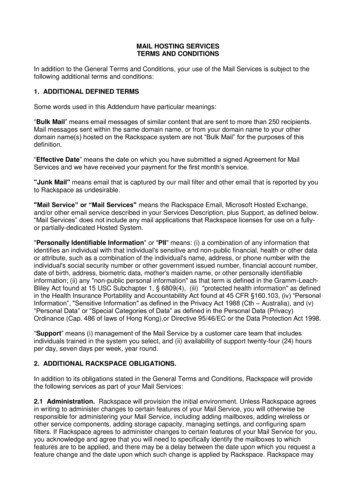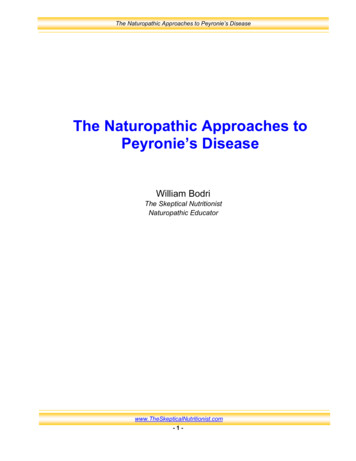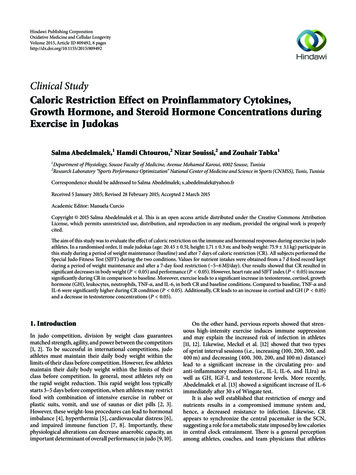
Transcription
Hindawi Publishing CorporationOxidative Medicine and Cellular LongevityVolume 2015, Article ID 809492, 8 pageshttp://dx.doi.org/10.1155/2015/809492Clinical StudyCaloric Restriction Effect on Proinflammatory Cytokines,Growth Hormone, and Steroid Hormone Concentrations duringExercise in JudokasSalma Abedelmalek,1 Hamdi Chtourou,2 Nizar Souissi,2 and Zouhair Tabka11Department of Physiology, Sousse Faculty of Medicine, Avenue Mohamed Karoui, 4002 Sousse, TunisiaResearch Laboratory “Sports Performance Optimization” National Center of Medicine and Science in Sports (CNMSS), Tunis, Tunisia2Correspondence should be addressed to Salma Abedelmalek; s abedelmalek@yahoo.frReceived 5 January 2015; Revised 28 February 2015; Accepted 2 March 2015Academic Editor: Manuela CurcioCopyright 2015 Salma Abedelmalek et al. This is an open access article distributed under the Creative Commons AttributionLicense, which permits unrestricted use, distribution, and reproduction in any medium, provided the original work is properlycited.The aim of this study was to evaluate the effect of caloric restriction on the immune and hormonal responses during exercise in judoathletes. In a randomised order, 11 male judokas (age: 20.45 0.51; height: 1.71 0.3 m; and body weight: 75.9 3.1 kg) participate inthis study during a period of weight maintenance (baseline) and after 7 days of caloric restriction (CR). All subjects performed theSpecial Judo Fitness Test (SJFT) during the two conditions. Values for nutrient intakes were obtained from a 7 d food record keptduring a period of weight maintenance and after a 7-day food restriction ( 5 6 MJ/day). Our results showed that CR resulted insignificant decreases in body weight (𝑃 0.05) and performance (𝑃 0.05). However, heart rate and SJFT index (𝑃 0.05) increasesignificantly during CR in comparison to baseline. Moreover, exercise leads to a significant increase in testosterone, cortisol, growthhormone (GH), leukocytes, neutrophils, TNF-𝛼, and IL-6, in both CR and baseline conditions. Compared to baseline, TNF-𝛼 andIL-6 were significantly higher during CR condition (𝑃 0.05). Additionally, CR leads to an increase in cortisol and GH (𝑃 0.05)and a decrease in testosterone concentrations (𝑃 0.05).1. IntroductionIn judo competition, division by weight class guaranteesmatched strength, agility, and power between the competitors[1, 2]. To be successful in international competitions, judoathletes must maintain their daily body weight within thelimits of their class before competition. However, few athletesmaintain their daily body weight within the limits of theirclass before competition. In general, most athletes rely onthe rapid weight reduction. This rapid weight loss typicallystarts 3–5 days before competition, when athletes may restrictfood with combination of intensive exercise in rubber orplastic suits, vomit, and use of saunas or diet pills [2, 3].However, these weight-loss procedures can lead to hormonalimbalance [4], hyperthermia [5], cardiovascular distress [6],and impaired immune function [7, 8]. Importantly, thesephysiological alterations can decrease anaerobic capacity, animportant determinant of overall performance in judo [9, 10].On the other hand, pervious reports showed that strenuous high-intensity exercise induces immune suppressionand may explain the increased risk of infection in athletes[11, 12]. Likewise, Meckel et al. [12] showed that two typesof sprint interval sessions (i.e., increasing (100, 200, 300, and400 m) and decreasing (400, 300, 200, and 100 m) distance)lead to a significant increase in the circulating pro- andanti-inflammatory mediators (i.e., IL-1, IL-6, and IL1ra) aswell as GH, IGF-I, and testosterone levels. More recently,Abedelmalek et al. [13] showed a significant increase of IL-6immediately after 30 s of Wingate test.It is also well established that restriction of energy andnutrients results in a compromised immune system and,hence, a decreased resistance to infection. Likewise, CRappears to synchronize the central pacemaker in the SCN,suggesting a role for a metabolic state imposed by low caloriesin central clock entrainment. There is a general perceptionamong athletes, coaches, and team physicians that athletes
2are more vulnerable to infections disease. Moreover, rapidweight reduction by energy restriction may have additionaldisadvantages in athletes who are in a chronic immunosuppressive state. In this context, Shimizu et al. [14] showed that2 weeks of weight loss before a competition can impair cellmediated immune function and induce high susceptibility toupper respiratory tract infections (URTIs) in judo athletes.Results of several studies have suggested adverse effectsof weight loss, including intensive training and energyrestriction, on immune parameters in athletes. Weight lossreportedly reduces neutrophil phagocytic activity [15], T-cellproliferation and cytokine production such as interferong [16], and leukocyte counts [8]. Some athletes undergoingweight loss are known to suffer from infections. Nevertheless,these alterations depend on the type of weight loss (i.e.,gradual or rapid weight loss), of the sport practised (i.e.,aerobic versus anaerobic), of the intensity of the exercise,of the type of diet (i.e., high fat or high carbohydrate diet),and of the amount lost. Moreover, many negative effects ofweight loss are reported by the authors; it is important to notethat these responses depend on the amount lost. However,the data are controversial [17, 18]. Numerous attempts havebeen made to investigate the effects of exercise training orenergy restriction on neutrophil functions [7, 19]. Thus, judois often considered to be an explosive sport which demandsgreat anaerobic strength and capacity [20], accompanied by awell-developed aerobic system [21].Additionally, studies investigating the effects of weightloss on performance utilized laboratory-based techniques,which may not reflect the demands of real judo combat.Therefore, a judo-specific performance test (Special JudoFitness Test, SJFT), which is more representative of judomovements than laboratory tests, has been proposed as avalid and reliable measure of performance in judo athletes[22, 23]. However, no report has described a study of theinfluences of weight loss on proinflammatory cytokines andsteroid hormones during intensive and specific exercises.Likewise, little information about judo demand and weightloss practices in judo athletes, especially concerning the testused to represent judo performance, was available.It is crucial, therefore, to investigate the effect of 7days’ food restriction on proinflammatory cytokines andsteroid hormones in male judo athletes preparing for anational championship. In view of the above consideration,the purpose of this study was to determine the effects ofcaloric restriction on IL-6, TNF-𝛼, testosterone, and cortisolduring SJFT in judo athletes. In light of the literature observations, we hypothesized that CR affects the proinflammatorycytokines and steroid hormone responses to the SJFT.2. Materials and Methods2.1. Participants. Eleven healthy judo athletes (mean ( SD);age: 20.45 2.51 years; height: 171.6 3.6 cm; and weight75.9 3.1 kg) participated in the study. After receiving athorough explanation of the protocol, they gave writtenconsent to participate in this study. This study protocolwas in accordance with the Helsinki Declaration for humanexperimentation and was approved by the university ethicsOxidative Medicine and Cellular Longevitycommittee. The participants were also selected based ontheir chronotype and on the basis of their answers to Horneand Ostberg [24] self-assessment questionnaire. They had anintermediate chronotype (i.e., sleep duration between 22:30 1:00 and 07:00 1:00 h) and kept standard times for eatingprior to the commencement of the study (breakfast at 07:00 1:00 h, lunch at 12:00 1:00 h, and dinner at 20:00 1:00 h).Their mean period of practising judo was 11.2 3.1 years.The participants’ technical levels were second and third Danblack belts. They competed in categories between 73 and80 kg weight category. Based on the results of a self-reportedquestionnaire, no subject had been treated with any drugthat is known to affect immune function, had experiencedacute illness from infection during the first three months,or had smoked tobacco regularly. Subjects reported no sleepdisorder and did not consume caffeine or any alcoholicbeverages and none of them was taking any medication. Alljudokas participated in official judo competitions during thisyear and trained for 16-15 hours per week.2.2. Experimental Design. During the week before the experiment, participants came to the laboratory several timesto become fully familiarized with the procedure and testsinvolved so as to minimize learning effects during the experiment. In a randomized order, subjects participated in twoexperimental test sessions. The first was a baseline conditionin which subjects were taking a normal diet (baseline). Thesecond is a condition of caloric restriction for 7 days; participants reduce their energy intake by 6.7 MJ/day (CR). Duringeach experimental condition, subjects performed the SJFT atthe same time of day (08:00 h). All experimental sessions werescheduled during a period with no official competitions.At the beginning of each session, the body weight, % fat,fat mass, fat-free mass, and body water were recorded usingbioelectrical impedance scale to the nearest 0.1 kg (Tanita,Tokyo, Japan) calibrated in accordance with the manufacturer’s guidelines by one trained technician. The body massindex (BMI; kg m 2 ) was then calculated. Following this,duplicate measurements were taken with participants standing and wearing only briefs, as recommended by the guidelines. The average of these two measurements was used for thefinal analysis. Moreover, the heart rate was monitored usingAutomatic Blood Pressure (Microlife, W90, Paris). Before themorning test sessions, only one glass (15 to 20 cl) of waterwas allowed to avoid postprandial thermogenesis effects.Throughout the experimental period, participants wererequired to maintain their habitual physical activity and toavoid strenuous physical efforts 24 h before each test session.2.3. Assessment of Dietary Intake. Nutritional assessmentwas carried out every 15 days to assess the energy intake ofthe subjects (i.e., fat, protein, and carbohydrate). Each subjectreceived recommendations needed to properly completethe food diaries. Thus, they detailed the food and beveragesconsumed during the 3 days prior to sampling. We askedsubjects to maintain their normal diet during the studyperiod (control period). Values for nutrient intakes wereobtained from a food diary for a holding period of weightand dietary restriction after 7 days. The plan was to carry out
Oxidative Medicine and Cellular Longevitydietary restriction ( 6 MJ/day) according to the report fromGiannini Artioli et al. [2]. All participants received a detailedverbal explanation and written instructions. The weight lossmethods used by athletes in this study appear to be generallyused [25]. Values of daily nutritional intake were calculatedusing dietary assessment software Nutrisoft-Bilnut (ver. 4,Paris, France).2.4. Special Judo Fitness Test (SJFT). To perform the SJFT,three athletes of similar body mass are needed: a participant(TORI) is evaluated, and 2 other individuals receive throws(UKES). The TORI begins the test in a position between the2 UKES who are standing 6 m away from one another. Ona signal, the TORI runs to one of the UKES and employs athrowing technique called ippon-seoi-nage. The TORI thenruns to the other UKE and completes another throw using thesame technique. The TORI must complete as many throwsas possible within the test time. The SJFT consists of threeperiods of 15 s (A), 30 s (B), and 30 s (C) separated by 10 srecovery intervals. Performance was determined by the totalnumber of throws completed during each of the SJFTs [21]. Inaddition, the following index was calculated [23]:Index final HR (bpm) HR 1 min after the end ofthe test (bpm)/total number of throws,where HR is the heart rate measured immediatelyafter the test and HR 1 is the heart rate measured 1 minafter the test.2.5. Blood Samples and Analyses. Blood samples were collected using an indwelling venous catheter before (P1) (after15 min of rest), immediately (P2), and 60 min after the exercise (P3). Then, plasma tubes were centrifuged at 3000 rpmfor 20 min at room temperature and stored at 80 C untilthe measurement of hormonal and immune parameters [26].All parameters were measured in triplicate for each sample.Leucocyte counts, lymphocyte, and neutrophil were obtainedusing an automated blood cell counter (Sysmex Kx-21N,Japan).GH concentrations were evaluated using the ST AIAPACK (Tosoh Bioscience). The ST AIA-PACK HGH is a twosite immunoenzymometric assay, which is performed entirelyin the AIA-PACK. The intra- and interassay coefficients ofvariation (CV) were 0.9% and 3.6%, respectively. The limitdetection was 0.07 ng/mL.Testosterone and cortisol concentrations were analysed by ELFA (Enzyme-Linked Fluorescent Assay; VIDAS,BioMerieux, France). The intra- and interassay CV were18.2% and 5.6% for testosterone and 2.7% and 5.8% forcortisol, respectively. The limit detections were 0.1 ng mL 1for testosterone and 2 ng mL 1 for cortisol.IL-6 and TNF-𝛼 were analyzed by ELISA (EnzymeLinked Immunoassay) using commercial kits: BE53061,Hamburg, Germany, and AbC223/3, Paris, respectively. Theintra- and interassay CV were 3.4% and 5.2% for IL-6 and6.9% and 7.4% for TNF-𝛼, respectively. All assays were carriedout as advised by the manufacturer’s directions. To eliminateinterassay variance, all samples for each subject were assayedin the same assay.3Table 1: Mean ( SD) values for daily nutrient consumption andanthropometrics parameters during baseline and CR conditions.Body mass (kg)BMI (Kg m2 )Body fat (kg)FFM (Kg)Body water (Kg)Energy intake (Kcal/day)Protein (g/day)Fat (g/day)Carbohydrates (g/day)Baseline75.9 3.125.8 1.112.09 1.0963.8 1.147.72 1.93475 247.6129.2 17.2117.6 12.6355.7 32.7CR72.73 3.1 24.7 1.01 10.84 1.5 61.8 1.5 41.8 1.8 2192 235.6 87.4 9.2 89.5 7.7 234.4 46.7 Significant difference: P 0.05 versus baseline.FFM: free fat mass; BMI: body mass index.Table 2: Mean ( SD) results of SJFT (i.e., performance and heartrate (HR)) in judo athletes during baseline and CR conditions.Total throws (1 2 3)HR immediately after exerciseHR after 1 minSJFT index Baseline31 2.65182.3 5.3154 2.810.8 3CR26.27 2.9 188 8.4 161 3.2 13.28 4 Significant difference: P 0.05 versus baseline.2.6. Statistical Analyses. Statistical tests were processed usingSTATISTICA Software (StatSoft, France). Data were reportedas mean SD. Once the assumption of normality wasconfirmed using the Shapiro-Wilk 𝑊-test, parametric testswere performed. Hormonal and inflammatory mediatorsdata were analyzed using a two-way ANOVA with repeatedmeasures (2 [diet condition] 3 [points of measurement]).The Bonferroni post hoc test was performed wheneversignificant effects or a significant interaction was foundusing ANOVA. Energy intake, anthropometric parameters,performance of SJFT, and heart rate were tested by a pairedStudent’s 𝑡-test. To assess the data practical significance, effectsizes were calculated as partial eta-squared, 𝜂𝑃 2 . Test-retestreliability was assessed by intraclass correlation coefficients(ICCs). The level of statistical significance was set at 𝑃 0.05.3. Results3.1. Body Mass and Energy Intake, Performance, and HeartRate. The statistical analysis showed significant effects ofcaloric restriction on body weight (𝑃 0.05), fat mass(𝑃 0.05), fat-free mass (𝑃 0.05), and body water (𝑃 0.001) with a significant decrease during CR in comparison tobaseline. Likewise, macronutrient intake showed significantdecrease during CR in comparison with baseline (𝑃 0.05) statistical differences (Table 1). Likewise, a significantdecrease in performance (i.e., total throws) (𝑃 0.05) wasobserved. The SJFT showed a high reliability between testretest sessions (ICC higher than 0.87). However, heart rate(i.e., HR immediately (𝑃 0.05) and 1 min after test (𝑃 0.05)) and SJFT index (𝑃 0.05) were significantly higherduring CR in comparison to baseline (Table 2).
4Oxidative Medicine and Cellular Longevity11180Testosterone (ng/mL)Cortisol (ng/mL)205 ¶155 ¶1301058055BeforeImmediately 9 ¶7¶¶5360 minImmediatelyBeforeAfter exercise60 minAfter exerciseBaselineCRBaselineCR(a)(b)4Growth hormone (ng/mL)3.5 ¶32.5 ¶21.510.5Before60 minImmediatelyAfter exerciseBaselineCR(c)Figure 1: Growth hormone (GH) (a), testosterone (b), and cortisol (c) concentrations (ng mL 1 ) measured before the exercise (P1) andimmediately (P2) and 60 min after (P3) the exercise during baseline and caloric restriction (CR) conditions. All values are expressed as mean( SD). indicates significant difference with (P1) during the same condition; ¶ indicates significant difference in comparison with baseline(𝑃 0.05).3.2. Hormone Concentrations. Exercise was associated withan increase in testosterone (𝐹(1,10) 5.56; 𝜂𝑃 2 0.54; 𝑃 0.05), GH (𝐹(1,10) 7.33; 𝜂𝑃 2 0.67; 𝑃 0.05), andcortisol (𝐹(1,10) 5.20; 𝜂𝑃 2 0.59; 𝑃 0.05) immediatelyafter the SJFT. Likewise, a significant diet condition effectin testosterone (𝐹(2,20) 63.35; 𝜂𝑃 2 0.77; 𝑃 0.05), GH(𝐹(2,20) 22.72; 𝜂𝑃 2 0.65; 𝑃 0.05), and cortisol concentrations (𝐹(2,20) 21.86; 𝜂𝑃 2 0.77; 𝑃 0.05) was observed(Figure 1). However, there was no significant interaction (dietcondition points of measurement) for testosterone andcortisol concentrations (𝑃 0.05). Moreover, concentrationsof testosterone, GH, and cortisol are significantly higher at P2in comparison with P1 and P3 during baseline and CR (𝑃 0.01). CR leads to a significant decrease in concentrationsof testosterone and significant increase in cortisol and GHconcentrations at P1, P2, and P3 (𝑃 0.05).3.3. Inflammatory Mediators. The effects of CR on inflammatory mediators during the exercise are summarized inFigure 2. Both CR and baseline conditions were associatedwith increases in IL-6 (𝐹(1,10) 120.3; 𝜂𝑃 2 0.81; 𝑃 0.001)and TNF-𝛼 (𝐹(1,10) 13.53; 𝜂𝑃 2 0.67; 𝑃 0.01) duringP2. A significant diet condition effect on the circulating IL6 (𝐹(2,20) 42.38; 𝜂𝑃 2 0.74; 𝑃 0.001) and TNF-𝛼 (𝐹(2,20) 32.04; 𝜂𝑃 2 0.69; 𝑃 0.001) was observed. However,the interaction diet condition points of measurement forplasma concentrations of IL-6 and TNF-𝛼 was not significant(Figure 2). Indeed, the increase in plasma concentrations ofIL-6 and TNF-𝛼 is significantly higher at P2 in comparisonwith P1 and P3 during CR in comparison with baseline (𝑃 0.05). Leukocytes (𝐹(2,16) 27.53; 𝜂𝑃 2 0.65; 𝑃 0.001)and lymphocytes (𝐹(2,16) 32.43; 𝜂𝑃 2 0.73; 𝑃 0.001)
51010998 ¶76 ¶543TNF-𝛼 (pg/mL)IL-6 (pg/mL)Oxidative Medicine and Cellular Longevity ¶8765432Before60 minImmediatelyAfter exercise2BeforeImmediately60 minAfter exerciseBaselineCRBaselineCR(a)(b)Figure 2: Plasma concentrations (pg/mL) of interleukin-6 (IL-6) (a) and TNF-𝛼 (b) measured before (P1) and immediately (P2) and 60 minafter (P3) the exercise during baseline and caloric restriction (CR) conditions. All values are expressed as mean ( SD). indicates significantdifference with (P1) during the same condition; ¶ indicates significant difference in comparison with baseline (𝑃 0.05).Table 3: Changes of hematological measurements measured before the exercise (P1) and immediately (P2) and 60 min after the exercise (P3)during baseline and CR.Leucocyte (103 /mm3 )Lymphocyte (%)Neutrophil (%)P17.4 0.3939.2 5.247.3 4.3BaselineP25.4 0.87 46.61 3.4 50.8 3.2 P35.9 0.16640.16 2.453.3 2.41P16.5 0.53¶36.2 2.9¶49.4 2.9¶CRP24.7 0.47 ¶38.3 4.7 ¶55.4 4.7 ¶P34.5 0.73¶34.2 5.3¶59.9 5.3¶ ¶Significant difference: P 0.05 versus P1.Significant difference: P 0.05 versus baseline.during the CR were significantly lower in comparison withbaseline whereas neutrophils (𝐹(2,16) 34.16; 𝜂𝑃 2 0.71; 𝑃 0.001) were significantly higher during the baseline thanCR conditions (Table 3). Lymphocytes (𝐹(1,8) 8.6; 𝜂𝑃 2 0.67; 𝑃 0.01) and neutrophils (𝐹(1,8) 9.7; 𝜂𝑃 2 0.66;𝑃 0.01) increased significantly at P2 compared to P1and remained significantly higher compared to their baselinevalue. However, leucocytes (𝐹(1,8) 7.77; 𝜂𝑃 2 0.63; 𝑃 0.01)were significantly lower during CR than baseline at P2.4. DiscussionThe results of this study showed that 7 days of CR leadsto alterations in immunological responses as well as steroidhormone during a high-intensity specific exercise in judoathletes. Indeed, IL-6, TNF-𝛼, GH, testosterone, and cortisolwere higher after exercise and remained elevated 60 minafter exercise during CR compared to the baseline. Likewise, leukocyte, lymphocyte, and neutrophil counts had asignificant variation through exercise during the CR and thebaseline conditions.Food records, as used in this study, are considered thestandard for dietary assessment and provide a quantitativeaccount of an individual’s diet during a specific period.Therefore, it is important to view the reported data of energyintake for these athletes.In this study, the caloric intake during the CR periodleads to a significant decrease in body weight (4.2 0.5%),which was in accordance with other athletes in combat sports[10, 27]. The loss of body weight represented an averageof 3.1 kg in absolute (Table 1). The deficit in energy intakerepresented about 6 MJ/day. Overall, our data show thatmost athletes usually lose weight rapidly before competitions.The average magnitude of weight reductions was around 5%of body weight (i.e., 2–5 times per year). In this context,Artioli et al. [28] observed a 4% reduction in body weightafter a 5-day weight loss period when compared to controlvalues. Likewise, Mendes et al. [29] showed a 5% reduction in body weight after a 5-day weight loss period. Themost frequent methods used by judo players were increasedexercise, restricted food ingestion, training in heated rooms,gradual dieting, and fluid restriction [2]. In accordance withseveral reports our results showed that rapid weight lossaffects negatively performance in judo athletes [4, 10].One can, then, put forward the hypothesis that the mainpart of the body weight loss observed during the dietaryrestriction is due to a body water loss. As a result, only 2%of fluid loss induces an increase in the heart rate and lowersthe stroke volume, which impairs cardiac output [30].Our results showed an increase in plasma concentrationsof cortisol, testosterone, and GH immediately after the exercise during the two experimental conditions (i.e., baseline
6and CR). It has, also, been shown that weight reduction maylead to alterations in lipid profile, as it is the case in our study,which may be the consequence of the increased hormonalresponses to the exercise. Our data are in agreement withprevious studies that showed an increase in testosterone andcortisol immediately after exercise [4, 31]. However, Opstad[32] and Axelsson et al. [33] found no change in cortisolconcentrations. The conflicting findings may be attributed tothe differences in the intensity and duration of exercise.More to the point, restrained eating may be a stressorwhich induced hormonal changes (i.e., decrease of testosterone and increase of cortisol). These data are in accordancewith the results of Anderson et al. [34]. The low carbohydrate intake may affect the cortisol levels [35]. Therefore,higher concentrations of cortisol may be a main factor inthe susceptibility to infections and injuries because of itsimmunosuppressive role [36]. By contrast, measurements oftestosterone showed decreases with diet and fluid restriction similar to those reported in several studies [37, 38].Strauss et al. [38] reported significant relationships betweentestosterone values, weight loss, body fat %, and body fat loss.It may be possible that the dehydration-induced weight lossand caloric restriction experienced by the judo athletes inthe present study combined with the high-intensity exercisecontributed to the reduced testosterone concentrations.Moreover, Loucks and Thuma [39] showed increase inGH, IGFBP1, and cortisol concentrations and a decrease inthe plasma concentration of IGF-1. Nindl et al. [31] observedthat brief periods of intense physical activity superimposedon energy and sleep restriction induced amplifications inGH and LH secretions. However, due to methodologicaldifferences such as exercise type (e.g., intensity and duration)or sleep loss protocol, the present study’s results cannot becompared with those of previous investigations.To our knowledge, this study is the first to report thathigh-intensity exercise induced changes on proinflammatorycytokines (i.e., IL-6 and TNF-𝛼) during 7 days of CR. Judo ischaracterised by high-intensity, short-duration exercise andit requires the athlete to use a combination of aerobic andanaerobic capacities.Our results showed that plasma concentrations of IL-6and TNF-𝛼 increased significantly during the exercise andremained elevated during the recovery period (i.e., 60 minafter the exercise) after CR. This report confirms cytokinesas effective markers of normal recovery after intense exercise.Consistently, previous reports showed that high-intensityexercise was associated with increase of proinflammatorycytokines, for example, IL-6 and TNF-𝛼 [40–42], which havebeen proposed as mediators of pathologies in humans andhave been shown to be associated with an unfavourablemetabolic profile with implications for inflammation and cardiovascular disease risk [12]. Furthermore, exercise inducesa general stress response involving the activation of theimmune systems and may induce immunosuppression inthe recovery period and continues to increase after exercise[12, 41]. Additionally, the concentrations of TNF-𝛼 have beenshown to increase by 2-3-fold after exercise [43]. The majorsource for the exercise-related IL-6 increase is the skeletalmuscle [44].Oxidative Medicine and Cellular LongevityAnother explanation suggested that glycogen depletion,a major stimulus for IL-6 release [42], caused by muscledamage was a further stimulus for the elevation of IL-6 during the recovery phase during CR condition. Furthermore,elevated plasma concentrations of IL-6 have been associatedwith the decrease of athletic performance and, therefore,increased levels of fatigue [45]. Regarding the effect of CR onimmune parameters, our results showed a significant increasein plasma concentrations of IL-6 and TNF-𝛼 following the7 days of CR. These results are in agreement with previousreports that showed an alteration of the various componentsof the immune system. Imai et al. [16] showed that weight lossdecreased T-cell proliferation and production of interleukin2 and interferon-g, whose cytokines induce T-cell activationand proliferation in wrestling athletes. In turn, fluid deficitsassociated with intensive exercise, particularly in hot environments, might be at least partly responsible for the alterationof immune function. Therefore, weight loss in athletes mightimpair T-cell activation. In highly trained athletes, URTIsare common reported illness [14]. Consequently, performing high-intensity exercise or periods of strenuous exercisetraining is associated with impairment of immune functionand a high risk of URTI in elite judo athletes. In this study,the increase of proinflammatory cytokines might be relatedto susceptibility to infection.4.1. Study Limitation. This study has some limitations. Therewas a smaller sample size of the subjects that limited ourpower to perform analyses. In addition, no control subjectswithout weight loss and without psychological stress relatedto an upcoming competition participated in this study.Additional studies must use proper number of weight lossand control subjects who are expending energy similar to thatused for judo (e.g., wrestling) but who are not participatingin the competition, who are not pursuing weight loss suchas open-category class athletes (e.g., 100 kg class in judo),and who perform either fluid restriction program or dietaryenergy restriction program. In addition, we did not measuredirect dehydration status such as urine specific gravity. Futurestudy needs to examine the influences of weight loss onimmune parameters and somatotropic axis (i.e., IGF-1) inparallel with hydration status.5. ConclusionIn conclusion, we conclude that 7 days of weight lossprograms undertaken in preparation for competition mightdegrade immune functions and conduct to the appearanceof infectious diseases such as URTI symptoms in male judoathletes by the increase of proinflammatory cytokines (i.e.,IL-6; TNF-𝛼). Despite conducting weight loss activities toachieve an advantage in competition, the consequent weightloss might impair immune functions as well as endocrinefunctions, thereby depressing the overall physical condition.Therefore, it is necessary for athletes to develop safer andmore effective weight loss programs. As a result, athletes,coaches, and medical staff should be sensitive to periodsof increased risk of disease (such as weeks of intensivetraining, the tapering period before the competition, and
Oxidative Medicine and Cellular Longevityduring the competition) and pay particular attention torecovery, the nutritional strategies, and optimal fluid intakeand should monitor athletes’ body weight, hydrated status,and immunocompetence to prevent their physical conditionfrom becoming ��:Special Judo Fitness TestGrowth hormoneCaloric restrictionUpper respiratory tract infectionsNatural killer cellsInterleukin-6Tumour necrosis factor-alpha.DisclaimerThe results of t
At the beginning of each session, the body weight, % fat, fat mass, fat-free mass, and body water were recorded using bioelectrical impedance scale to the nearest .kg (Tanita, Tokyo, Japan) calibrated in accordance with the manufac-turer s guidelines by one trained technician. e body mass index (BMI; kg m 2) was then calculated. Following this,



